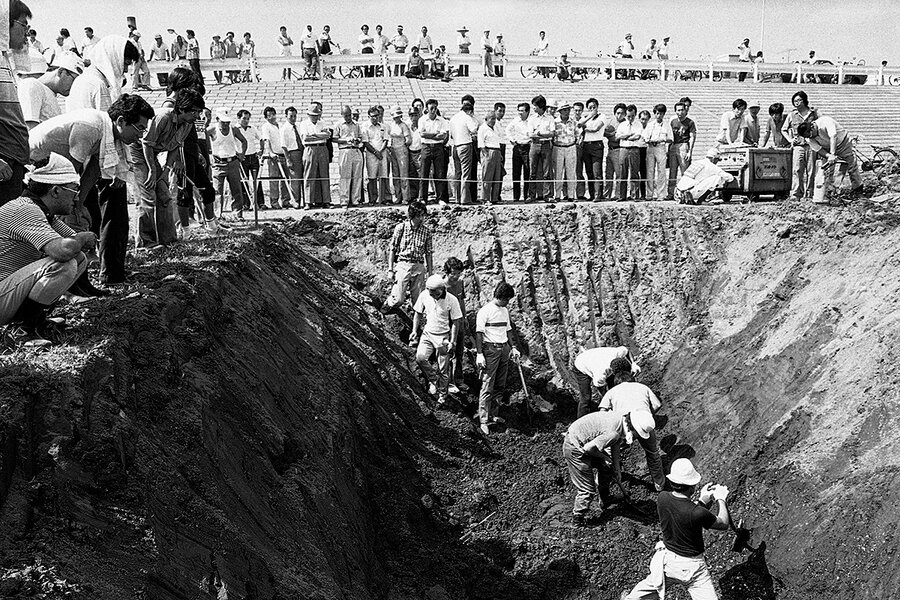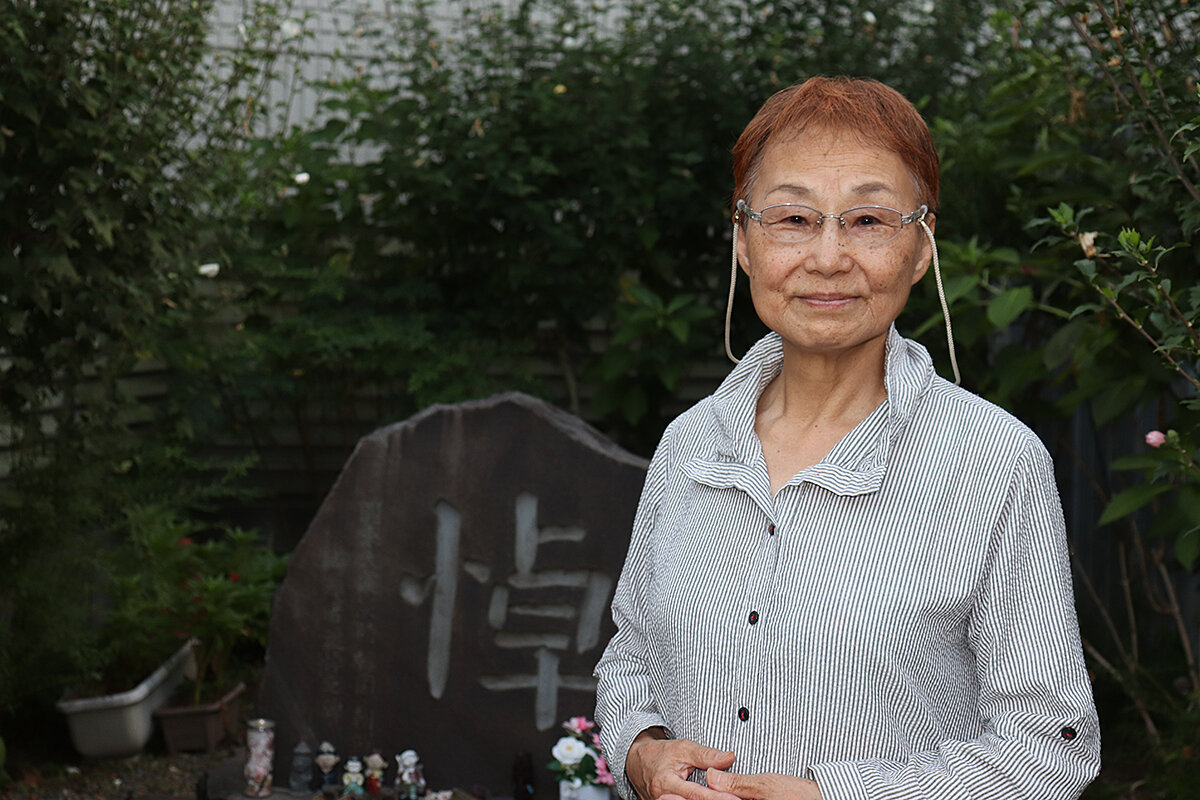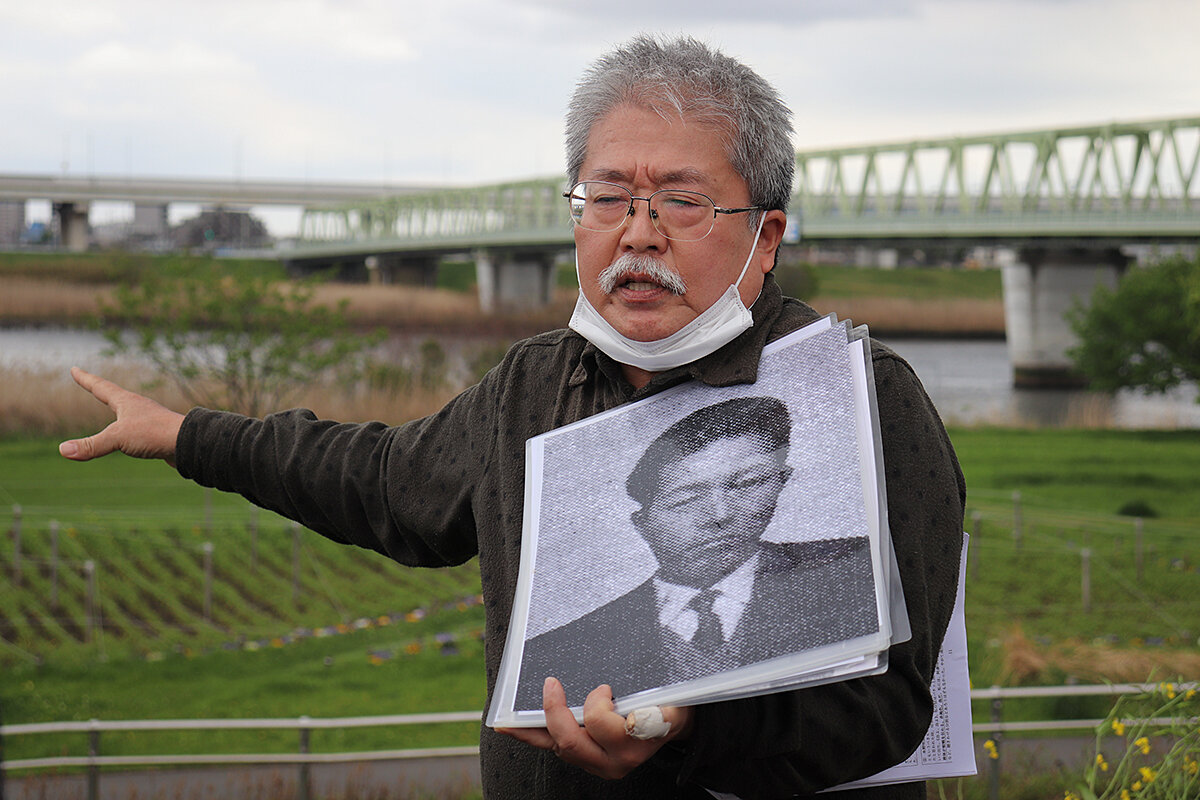For Koreans in Japan, this little-known massacre still carries weight
Loading...
| Tokyo
Despite searing heat and syrupy humidity, hundreds of people are set to gather on the bank of the Arakawa River in Tokyo this weekend to pay tribute to the Koreans who died 100 years ago in an oft-forgotten massacre.
Amid the chaos after the Great Kanto earthquake on Sept. 1, 1923, Japanese authorities spread rumors that immigrants from Korea – then a colony of Japan – were starting riots, setting fires, and poisoning city wells. More than 6,600 Koreans were slaughtered by military, police, and vigilante groups in the days following the earthquake. On this peaceful riverbank, where overgrown weeds sway around a makeshift venue, Japanese soldiers killed dozens of men execution style, according to accounts collected by Housenka, a civic group that’s been organizing the anniversary event since 1982.
Historians say the massacre was driven by the government’s growing concerns about Korean independence, as well as xenophobia and anti-Korean sentiment among the general population. Even today, Japanese-born Koreans are not granted citizenship or allowed to vote. They have long been targets of discrimination and hate speech, especially amid North Korea’s provocations. And while many Japanese honor the lives lost in the Great Kanto earthquake, relatively few know about the subsequent massacre. That’s at least partly because the government refuses to acknowledge the killings – something advocates say would help bring awareness to the problems Koreans face in present-day Japan.
Why We Wrote This
A story focused onJapan is reluctant to acknowledge colonial-era violence, leaving the job of historical reckoning to individuals and civic groups. For Koreans investigating a 1923 massacre, it’s not just a matter of truth, but also one of dignity and survival.
“Amid the cold war between the U.S. and Soviet Union, Japan was able to return to the international community without reflecting on its colonialism seriously,” says Tanaka Hiroshi, a Hitotsubashi University professor emeritus of history. “China and Korea suffered most from Japan’s wartime aggression. But each remains divided. In fact, Japan gained a huge financial windfall from the Korean War, laying the groundwork for becoming a major economic power.”
Mr. Tanaka adds that “while the government has done nothing,” citizen groups like Housenka are playing an important role in unearthing information about the massacre and educating the public. In fact, Housenka expects record attendance at the centennial anniversary, reflecting years of efforts to foster community and draw attention to anti-Korean discrimination, past and present.
Building bridges
To wrap one’s head around the massacre, experts say it’s important to understand the climate in Japan when the earthquake hit. Koreans had recently taken to the streets in Seoul to demand independence from Imperial Japan. Authorities violently suppressed these demonstrations, but feared that independence movement leaders might forge ties with socialists and labor activists in Japan. The disaster also struck at a time when more Koreans and Chinese were coming to Japan for jobs, stoking fears among Japanese workers that they were being replaced. In addition to targeting Korean residents, Japanese socialists and hundreds of Chinese immigrants were also killed during the attacks.
When Shin Minja, a second-generation ethnic Korean who leads Housenka, first learned of the massacre decades ago, her initial thought was that Korean-Japanese relations hadn’t improved all that much.
“I feared that I may be killed by Japanese people should something [like the earthquake] happen,” she says. “I thought that maybe Japanese people also fear that they may end up killing Koreans.”
Despite the island nation’s growing embrace of Korean films, TV, music, and consumer goods, the estimated 411,000 ethnic Koreans living in Japan are still treated as second-class citizens.
Anti-Korean sentiment is pervasive among right-wing political groups and mainstream media, and Japan’s Korean population often gets caught in the middle of conflicts between Japan and North Korea. In 2013, for example, Japan decided to eliminate schools for Korean children from its tuition waiver program, citing “lack of progress” on the long-deadlocked issue of North Korean abductions of Japanese nationals in the 1970s and 1980s.
For her, the solution was two-fold: fact-finding and community-building.
Ms. Shin has tried to get more Japanese people to know their Korean neighbors by attending community gatherings and hand-delivering her group’s newsletter to local assembly members. When she had Korean children dance at a community center event, she says she saw “Japanese people [who] were moved to tears.”
Housenka bought a plot of land along the Arakawa River and constructed a monument to the massacre victims in 2009, after an unsuccessful crusade to get the local government to help erect one.
Confronting the past
Tani Koichi, chairperson of the National Public Safety Commission, told a parliament committee meeting earlier this year that “we have not been able to locate government records that enable us to grasp the facts,” a sentiment echoed nearly verbatim by government spokesperson Matsuno Hirokazu at a press conference on Wednesday. Critics accuse the government of playing dumb.
Former public school teacher and Housenka leader Nishizaki Masao spent years combing through public library collections in Tokyo, and compiled more than 1,100 witness accounts of the massacre into a book.
“If we had a government that had conducted thorough investigation into the massacre and implemented appropriate measures, it would never tolerate hate speech toward Koreans,” says Mr. Nishizaki, who is Japanese.
Tokyo-based artist Kim Youngsuk wasn’t particularly interested in ruminating on such a tragic event until she joined Mr. Nishizaki for a tour of the massacre sites back in May, at the encouragement of some friends.
“Mr. Nishizaki has dedicated much of his life to confronting the massacre,” says Ms. Kim, a third-generation Korean. “I was also impressed by how Japanese participants [in his fieldwork] are facing the past.”
Her multi-media installations inspired by the violence were featured in the Aigo Exhibition in Yokohama, Japan, which commemorates the victims of the massacre. The exhibition moved to Seoul on Sept. 1.
Ms. Shin says these exhibits and memorial events give Japanese people a chance to learn not just about the 1923 massacre, but the issues Koreans are facing today.
“As Koreans living in Japan, we have nothing to lose. I’m Korean, a woman, a divorcee, and I raised three children, so you know I’m a very tough-minded person,” she says, smiling proudly.







